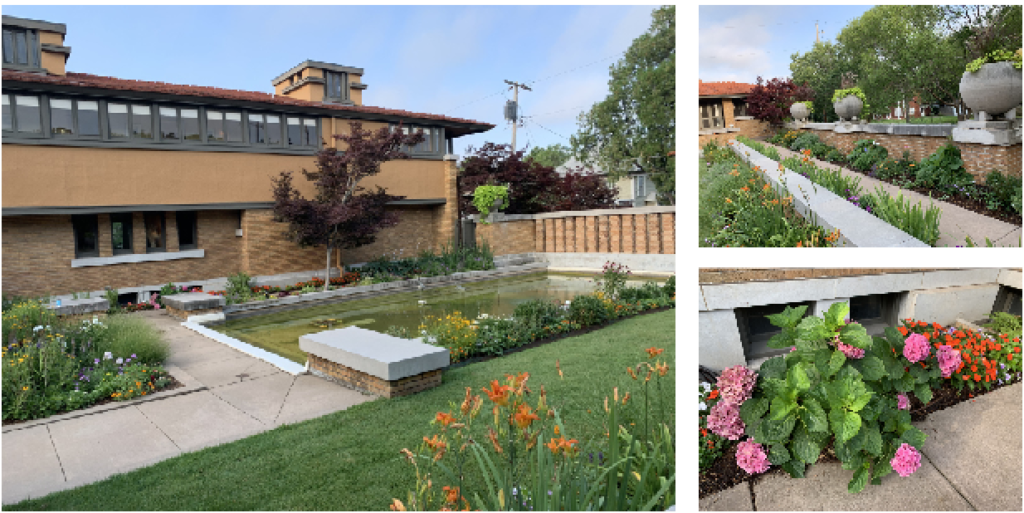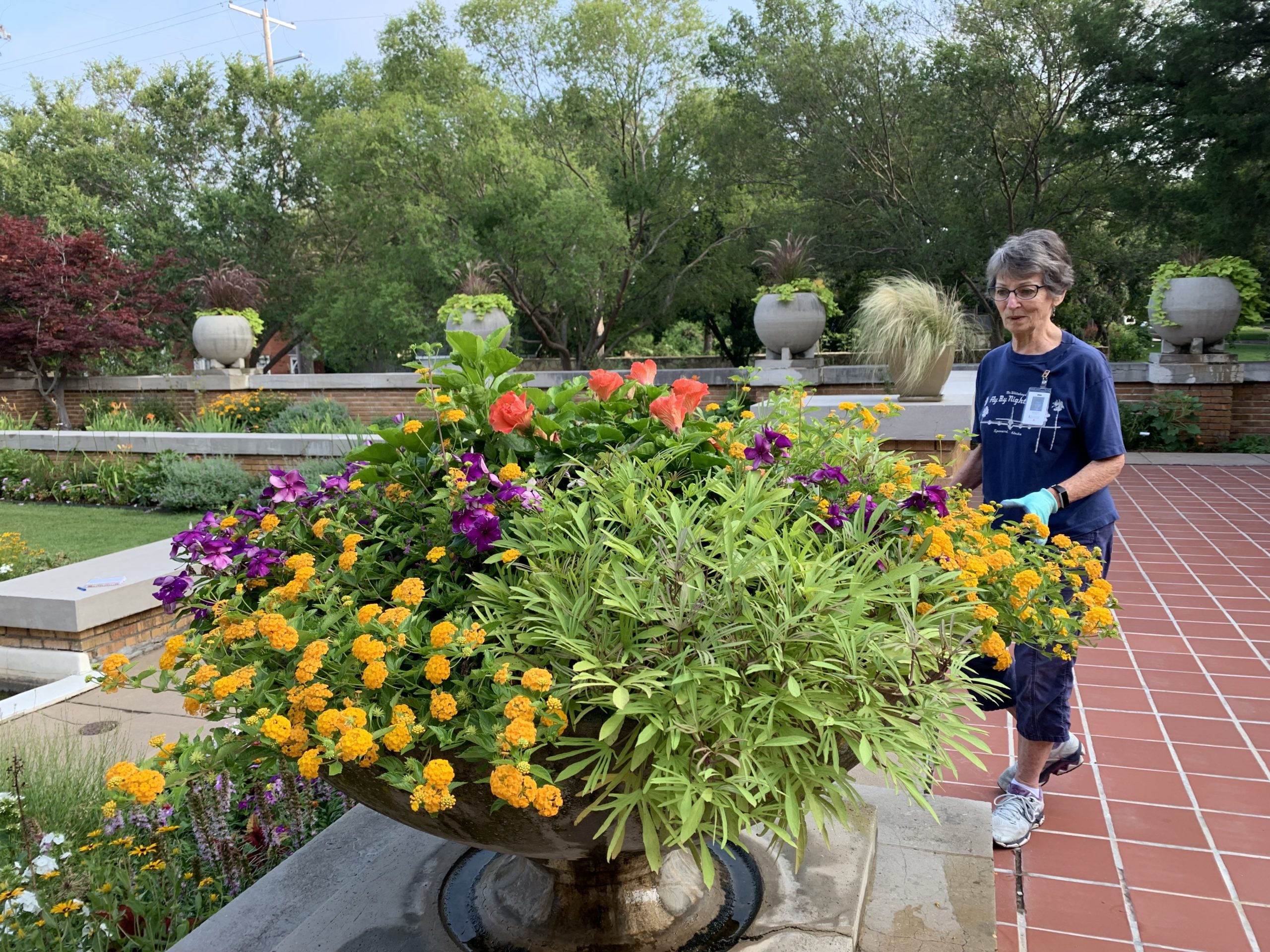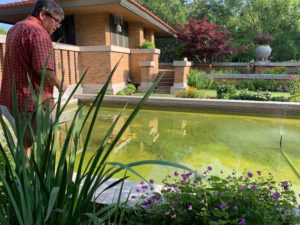By Annie Calovich
Visitors to the Frank Lloyd Wright house in College Hill have always been amazed at the pristine condition of the restored interior of the residence.
The grounds surrounding the house, on the other hand, for a long while did not reflect the admirable inside, which is now a museum.
But local master gardeners have lately been transforming the landscape into something worthy of one of Wichita’s top attractions. The residence at 255 N. Roosevelt that was the last of the architect’s prairie houses now has its own pretty prairie of a yard.
“It started in late 2015. I signed up to be a tour guide for the inside of the house, and I noticed that the back gardens didn’t do the house any favors,” Tim Reimer, a retired bank examiner for the FDIC, said recently in the midst of the busyness of his volunteer gigs. “There was Bermuda, clumps of daylilies and iris that pretty much survive on their own in Kansas. I thought it could use some help.”

The pond behind the Allen House is home to a rebounding school of koi fish while Japanese maples reflect Wright’s work on the Imperial Hotel in Tokyo around the time he designed the house. Ball pots are another hallmark of the home. This hydrangea is thought to date back to the original owners. Tim Reimer, below, says the pond was never meant to be a crystal-clear pool.
That same year saw Reimer in training to be a master gardener through K-State Research & Extension in Sedgwick County. His two new volunteer interests came together.
“I put the word around in the master gardener program,” he said, seeking to have his colleagues join him at the Wright house. “The master gardeners do work in other gardens in the county on the side. About 10 of us decided to see what we could do.”
The result is a colorful exuberance of native Kansas plants, tropical annuals and favorite plants of Wright and of the original residents of the house, newspaper publisher Henry Allen and his wife, Elsie. What has become known as the Allen House at 255 N. Roosevelt was commissioned in 1916 and completed in 1918.
“I think the house is just a real treasure in Wichita,” said Joan Fox, another master gardener who got in on the project. “People come there from all over the world, and a couple of years ago I visited the Frank Lloyd Wright house in Oregon, and the grounds were just pitiful. I think we just want to make this all we can make it.”
That doesn’t mean grandiose gardens, however. Wright’s emphasis was the architecture, not the landscaping. Early photos of the Allen House yield little evidence for those trying to replicate what was planted there before. Interim owners made a lot of changes, and the backyard pond is said to have been a swimming pool at one time. Well, more of a wading pool. The water only reaches to around the shins.
But there are a few clues and remnants of plants from the time when the Allens lived there. Red Japanese maples are pretty much the only trees on this prairie, illustrations of the fact that Wright was doing design work on the Imperial Hotel in Tokyo at the same time he was working on the Allen House. An old pink hydrangea in the back yard, thought to have belonged to Elsie Allen, has been brought back to vigor and even propagated by master gardener Euel Reed. The Allens also are known to have liked hollyhocks and sweet-potato vine, and ferns have always had their place in the yard. Built-in window boxes, large concrete ball planters and a Wright-designed urn are part of the original design elements.
Working with these givens, along with reviewing landscaping of typical houses of the 1920s, “we started to transform the way the backyard looks,” Reimer said.
The aim was to play up the house without upstaging it.
That means drifts of plants punctuated by vertical exclamation points that serve to accentuate the horizontal lines of the house. Most of the master-gardener additions have been flowers: native plants that would have been around at the time of the building of the house — black-eyed Susans, coreopsis, penstemon, gaillardia, phlox, salvia — and newer annual varieties such as Electric Orange Sunpatiens in summer and ornamental kale and pansies in fall and winter that help bridge color gaps in the perennials and provide interest year-round. The color palette is mainly purples, oranges and yellows to complement and pop against the house’s earth-toned brick.
“We think it’s wonderful,” said Amy Reep, executive director of the Allen House. “The visitors that come through love the landscaping. They all comment on how beautiful it is. They all want to come back for different seasons. There’s always something blooming. … That takes a lot of planning.”
It’s also taken a lot of trial-and-error thanks to challenges built in by Wright himself.
“There are large overhanging eaves that keep rainwater from getting into sections,” Reimer said. The eaves similarly keep out the sun. One difficult northwest-facing corner has three different zones in it ranging from deep shade to hot afternoon sun. The master gardeners currently have settled for a recipe of rudbeckia and milkweed in the sunny front, regressing to dragon-wing begonias, elephant ears and caladiums toward the shady back. Coleus are planted in a short window box above.
What Wright envisioned also isn’t always what modern-day visitors expect to see. The pond in the back yard is a good example.
“Most people look at it and say, ‘It’s a koi pond,’ and expect a crystal-clear pond,” Reimer said. “Frank Lloyd Wright referred to it as the bog pond, and the roof drains into it, and a couple of other pipes … so debris from that flows into it, so it tends to be cloudy. It used to have reeds at one end of it. It was never intended to be a swimming pool or a crystal-clear fish pond.”
Koi fish do thrive in it — as long as the herons and the egrets leave them alone. A floating alligator head and a motion-sensor sprinkler have proved to be sufficiently frightening lately.
The run-off also dictates an organic garden. Any pesticides would flow into the pond. Lately, the master gardeners have been irritated to find crown borers embedding themselves in a stand of black-eyed Susans near the pond. Stems of flowers start to wilt, then brown. For now they’ simply get pulled.
The master gardeners get together every Monday morning to work on the gardens during most of the year, with other times thrown in during the busy spring season. When individual gardeners happen to be in the neighborhood, they stop by to check on things and grab a hose if they see a dry spot that the irrigation system didn’t reach.
“We’ve always relied on volunteers, and the garden there is a full-time job, so when the master gardeners came to us, of course we were thrilled,” executive director Reep said.
The gardening is hard work, and while some of the original master gardeners have aged out, Reimer said, the ones who remain consider it a privilege to work on the grounds of a Wright house and fulfilling to contribute to the beauty and vibrancy of it. They also are able to bring their own interests to the garden. Fox is interested in pollinator plants, another in koi ponds.
“We think the gardens look great. They certainly look dramatically different from four years ago,” Reimer said.
“The emphasis is on the architecture and not the gardens, but I’ll tell you, two to three years of compost and tailored watering and weekly attention allow the flowers to take more of a center stage.”
And more of the public will get to see that next summer, when the grounds of the Allen House will be one stop on a garden tour sponsored by the master gardeners in June.
Contact Annie Calovich at acalovich@att.net.










